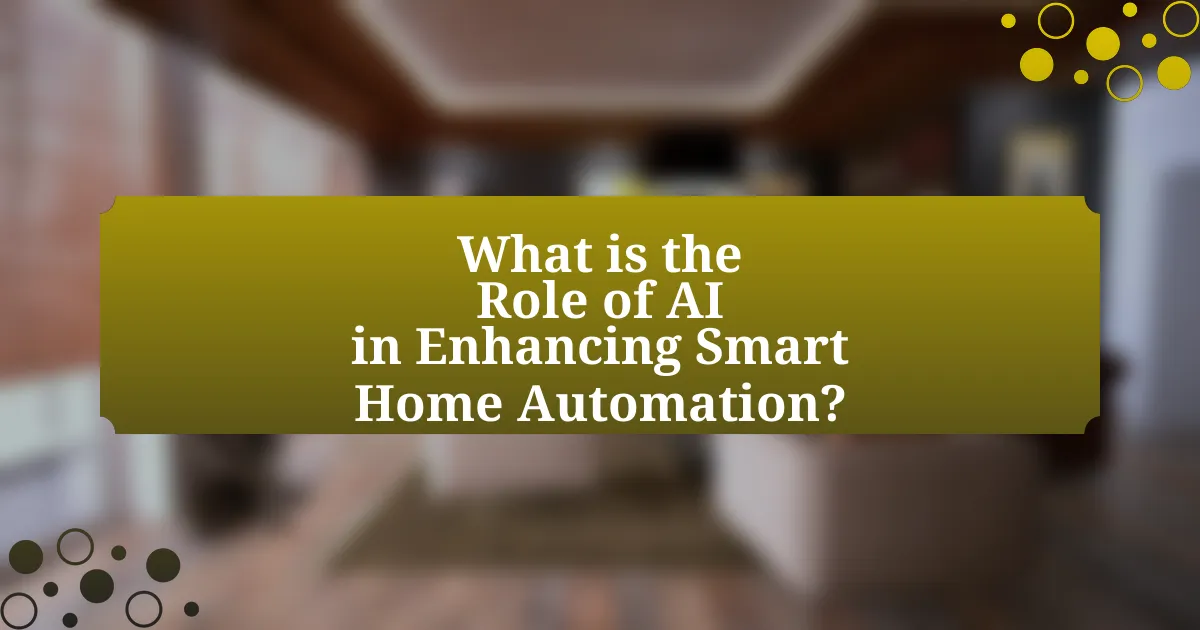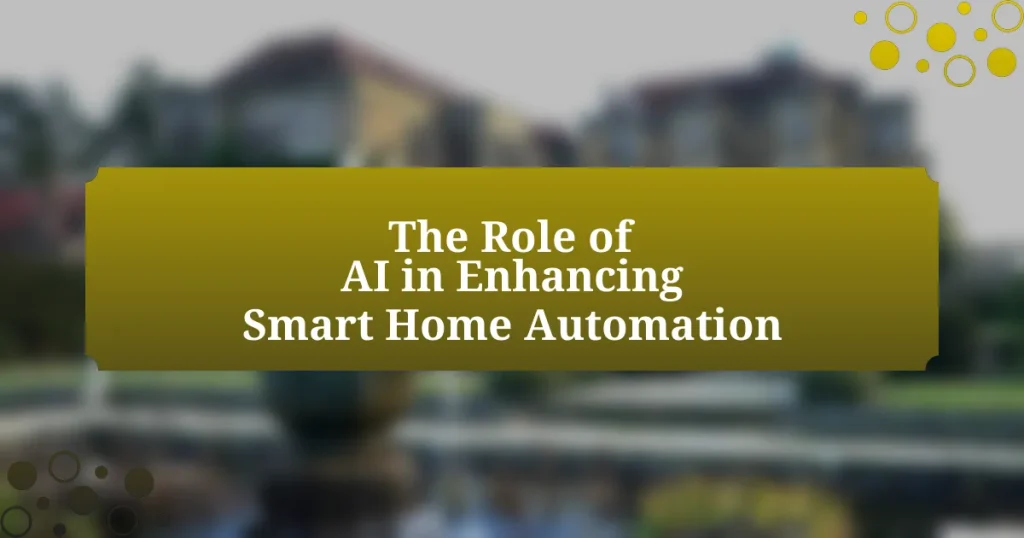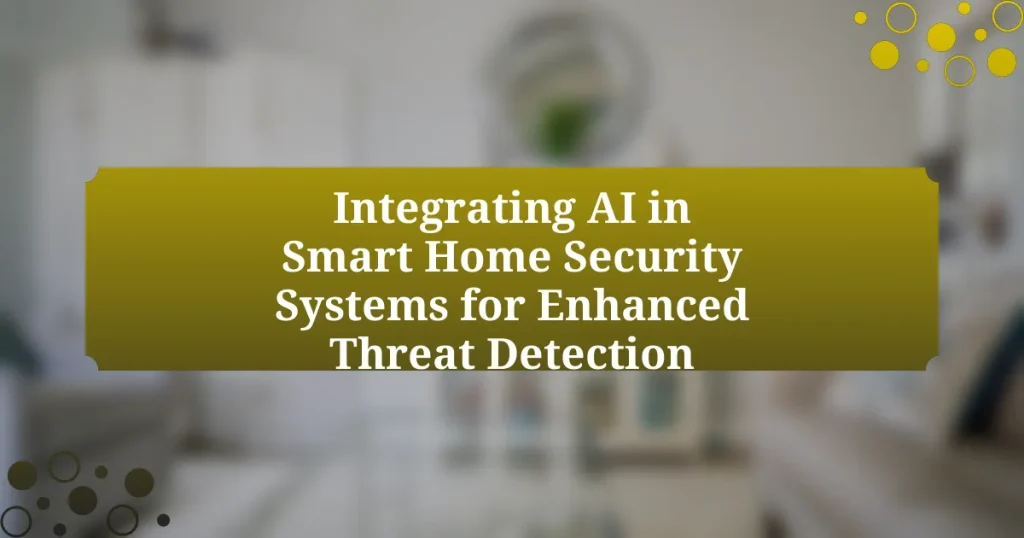The article focuses on the role of artificial intelligence (AI) in enhancing smart home automation. It explores how AI enables devices to learn user preferences, automate tasks, and improve security through data analysis and machine learning algorithms. Key features discussed include intelligent control, predictive analytics, and enhanced security measures, which collectively contribute to energy efficiency and user convenience. The article also addresses challenges such as interoperability, security, and privacy concerns, while highlighting future trends and best practices for effective AI integration in smart homes.

What is the Role of AI in Enhancing Smart Home Automation?
AI plays a crucial role in enhancing smart home automation by enabling devices to learn user preferences and automate tasks accordingly. Through machine learning algorithms, AI analyzes data from various sensors and user interactions to optimize energy consumption, improve security, and enhance convenience. For instance, AI-powered systems can adjust heating and lighting based on occupancy patterns, leading to energy savings of up to 30%. Additionally, AI enhances security by utilizing facial recognition and anomaly detection to identify potential threats, thereby increasing safety in smart homes.
How does AI integrate with smart home devices?
AI integrates with smart home devices by enabling them to learn user preferences, automate tasks, and enhance security through data analysis and machine learning algorithms. For instance, AI-powered systems can analyze patterns in energy usage to optimize heating and cooling, leading to increased energy efficiency. Additionally, AI enhances voice-activated assistants, allowing users to control devices seamlessly through natural language processing. According to a report by Statista, the global smart home market is projected to reach $174 billion by 2025, highlighting the growing reliance on AI for improved functionality and user experience in smart home environments.
What types of smart home devices benefit from AI integration?
Smart home devices that benefit from AI integration include smart thermostats, security cameras, smart speakers, and smart lighting systems. Smart thermostats, like the Nest Learning Thermostat, use AI to learn user preferences and optimize energy consumption, resulting in energy savings of up to 15%. Security cameras, such as those from Ring, utilize AI for facial recognition and motion detection, enhancing home security by reducing false alarms. Smart speakers, exemplified by Amazon Echo, leverage AI for voice recognition and personal assistant capabilities, allowing users to control other smart devices seamlessly. Lastly, smart lighting systems, like Philips Hue, employ AI to automate lighting based on user behavior and preferences, improving convenience and energy efficiency.
How does AI improve the functionality of these devices?
AI enhances the functionality of smart home devices by enabling them to learn user preferences and automate tasks accordingly. For instance, AI algorithms analyze data from user interactions to optimize energy consumption, improve security features, and provide personalized experiences. Research indicates that smart thermostats, equipped with AI, can reduce energy costs by up to 15% by adjusting settings based on user behavior patterns. Additionally, AI-driven security systems can identify unusual activities and alert homeowners in real-time, significantly increasing safety. These advancements demonstrate how AI not only improves efficiency but also enhances user convenience and security in smart home automation.
What are the key features of AI in smart home automation?
The key features of AI in smart home automation include intelligent control, predictive analytics, and enhanced security. Intelligent control allows devices to learn user preferences and automate tasks, such as adjusting lighting and temperature based on individual habits. Predictive analytics utilizes data to anticipate user needs, optimizing energy consumption and improving efficiency. Enhanced security features leverage AI for real-time monitoring and threat detection, utilizing facial recognition and anomaly detection to protect homes. These features collectively improve user convenience, energy efficiency, and safety in smart home environments.
How does AI enable voice control in smart homes?
AI enables voice control in smart homes by utilizing natural language processing (NLP) and machine learning algorithms to interpret and respond to user commands. These technologies allow smart home devices to understand spoken language, recognize context, and execute tasks such as adjusting lighting, controlling temperature, or managing security systems. For instance, AI systems like Amazon Alexa and Google Assistant leverage vast datasets to improve their understanding of various accents and dialects, enhancing user interaction. This capability is supported by advancements in speech recognition technology, which has shown a significant increase in accuracy, with some systems achieving over 95% recognition rates in controlled environments.
What role does machine learning play in smart home automation?
Machine learning plays a crucial role in smart home automation by enabling systems to learn from user behavior and preferences, thereby optimizing home management. Through algorithms that analyze data from various sensors and devices, machine learning allows smart home systems to predict user needs, automate tasks, and enhance energy efficiency. For instance, a study by the International Journal of Smart Home indicates that machine learning algorithms can reduce energy consumption by up to 30% by adjusting heating and cooling based on occupancy patterns. This capability not only improves convenience but also contributes to sustainability in smart home environments.
What challenges does AI face in smart home automation?
AI faces several challenges in smart home automation, including interoperability, security, and user privacy. Interoperability issues arise because various smart devices often use different communication protocols, making it difficult for AI systems to integrate and control them seamlessly. Security concerns are significant, as smart home devices can be vulnerable to hacking, potentially compromising user data and safety. Additionally, user privacy is a challenge, as AI systems require access to personal data to function effectively, raising concerns about data misuse and surveillance. These challenges hinder the widespread adoption and effectiveness of AI in smart home environments.
How do privacy concerns impact AI implementation in smart homes?
Privacy concerns significantly hinder AI implementation in smart homes by creating distrust among users regarding data security and surveillance. When individuals fear that their personal information may be misused or inadequately protected, they are less likely to adopt smart home technologies. For instance, a survey by the Pew Research Center found that 81% of Americans feel that the potential risks of data collection by companies outweigh the benefits. This apprehension leads to stricter regulations and demands for transparency from manufacturers, which can slow down innovation and deployment of AI solutions in smart home environments.
What are the technical limitations of AI in smart home systems?
The technical limitations of AI in smart home systems include issues related to interoperability, data privacy, and reliance on internet connectivity. Interoperability challenges arise because various smart devices often use different communication protocols, making it difficult for AI systems to integrate and manage them seamlessly. Data privacy concerns stem from the collection and processing of personal information, which can lead to vulnerabilities if not properly secured. Additionally, many AI-driven smart home systems depend heavily on stable internet connections; disruptions can hinder functionality and limit the effectiveness of automation. These limitations highlight the need for standardized protocols, robust security measures, and reliable connectivity solutions in the development of smart home technologies.
How does AI enhance user experience in smart home automation?
AI enhances user experience in smart home automation by providing personalized control and automation of devices. Through machine learning algorithms, AI analyzes user behavior and preferences, allowing for tailored automation scenarios that adapt to individual lifestyles. For instance, AI can learn a user’s daily routines, adjusting lighting, temperature, and security settings accordingly, which increases convenience and comfort. Additionally, AI-powered voice assistants facilitate seamless interaction with smart devices, enabling users to control their environment through natural language commands. This integration not only simplifies user engagement but also improves accessibility for individuals with disabilities, making smart home technology more inclusive.
What personalized features does AI offer to users?
AI offers personalized features to users by adapting smart home systems to individual preferences and behaviors. These features include automated scheduling of devices based on user routines, personalized recommendations for energy usage, and voice recognition that tailors responses to specific users. For instance, smart thermostats learn user temperature preferences over time, optimizing comfort and energy efficiency. Additionally, AI can analyze user interactions to suggest new functionalities or devices that enhance the smart home experience, thereby improving overall user satisfaction and convenience.
How does AI contribute to energy efficiency in smart homes?
AI contributes to energy efficiency in smart homes by optimizing energy consumption through intelligent automation and predictive analytics. Smart thermostats, powered by AI, learn user behavior and adjust heating and cooling systems accordingly, resulting in energy savings of up to 10-15% annually. Additionally, AI algorithms analyze data from various sensors to manage lighting and appliances, ensuring they operate only when needed, further reducing energy waste. Studies indicate that homes equipped with AI-driven systems can achieve a 20-30% reduction in energy usage compared to traditional homes, demonstrating the significant impact of AI on energy efficiency.
What future trends can we expect in AI and smart home automation?
Future trends in AI and smart home automation include increased integration of machine learning algorithms for personalized user experiences and enhanced interoperability among devices. As AI technology advances, smart home systems will leverage data analytics to learn user preferences, enabling automation that adapts to individual lifestyles. Furthermore, the rise of edge computing will facilitate faster processing of data locally, improving response times and reducing latency in smart home applications. According to a report by MarketsandMarkets, the smart home market is projected to grow from $80.21 billion in 2022 to $135.3 billion by 2025, indicating a significant shift towards more sophisticated AI-driven solutions in home automation.
How will advancements in AI technology shape smart home automation?
Advancements in AI technology will significantly enhance smart home automation by enabling more intuitive, efficient, and personalized home management systems. AI algorithms can analyze user behavior and preferences, allowing devices to adapt and respond proactively to individual needs. For instance, smart thermostats can learn a household’s schedule and adjust temperatures accordingly, leading to energy savings of up to 10-15% as reported by the U.S. Department of Energy. Furthermore, AI-powered voice assistants can integrate with various smart devices, facilitating seamless control and automation through natural language processing, which enhances user experience and accessibility. These advancements will lead to smarter, more responsive homes that improve comfort, security, and energy efficiency.
What emerging technologies are likely to influence AI in smart homes?
Emerging technologies likely to influence AI in smart homes include edge computing, 5G connectivity, and advanced sensor technologies. Edge computing enables data processing closer to the source, reducing latency and improving real-time decision-making for smart devices. 5G connectivity enhances communication speed and bandwidth, allowing for seamless integration of multiple devices and applications. Advanced sensor technologies, such as IoT sensors, provide rich data inputs that AI algorithms can analyze to optimize home automation and energy management. These technologies collectively enhance the efficiency and responsiveness of AI systems in smart homes.
What best practices should users follow for effective AI in smart home automation?
To achieve effective AI in smart home automation, users should prioritize integration, security, and user customization. Integration ensures that various smart devices communicate seamlessly, enhancing overall functionality. For instance, using platforms like Google Home or Amazon Alexa allows for centralized control of multiple devices, improving user experience. Security is crucial; users must regularly update device firmware and utilize strong passwords to protect against vulnerabilities. According to a 2021 report by the Cybersecurity & Infrastructure Security Agency, 70% of smart home devices have known security flaws, emphasizing the need for vigilance. Lastly, user customization enables tailored automation scenarios, such as setting specific routines based on individual preferences, which can significantly enhance convenience and efficiency.














